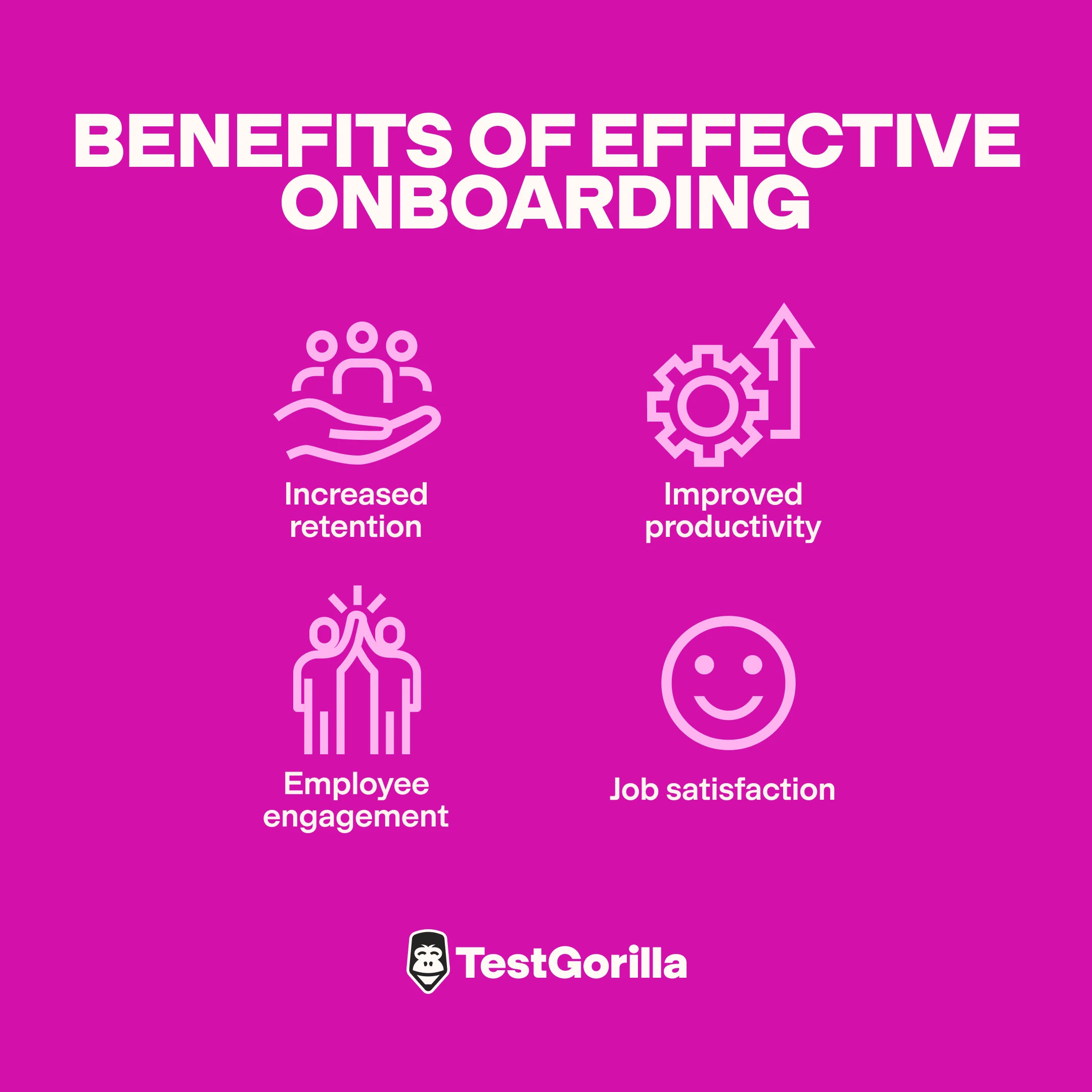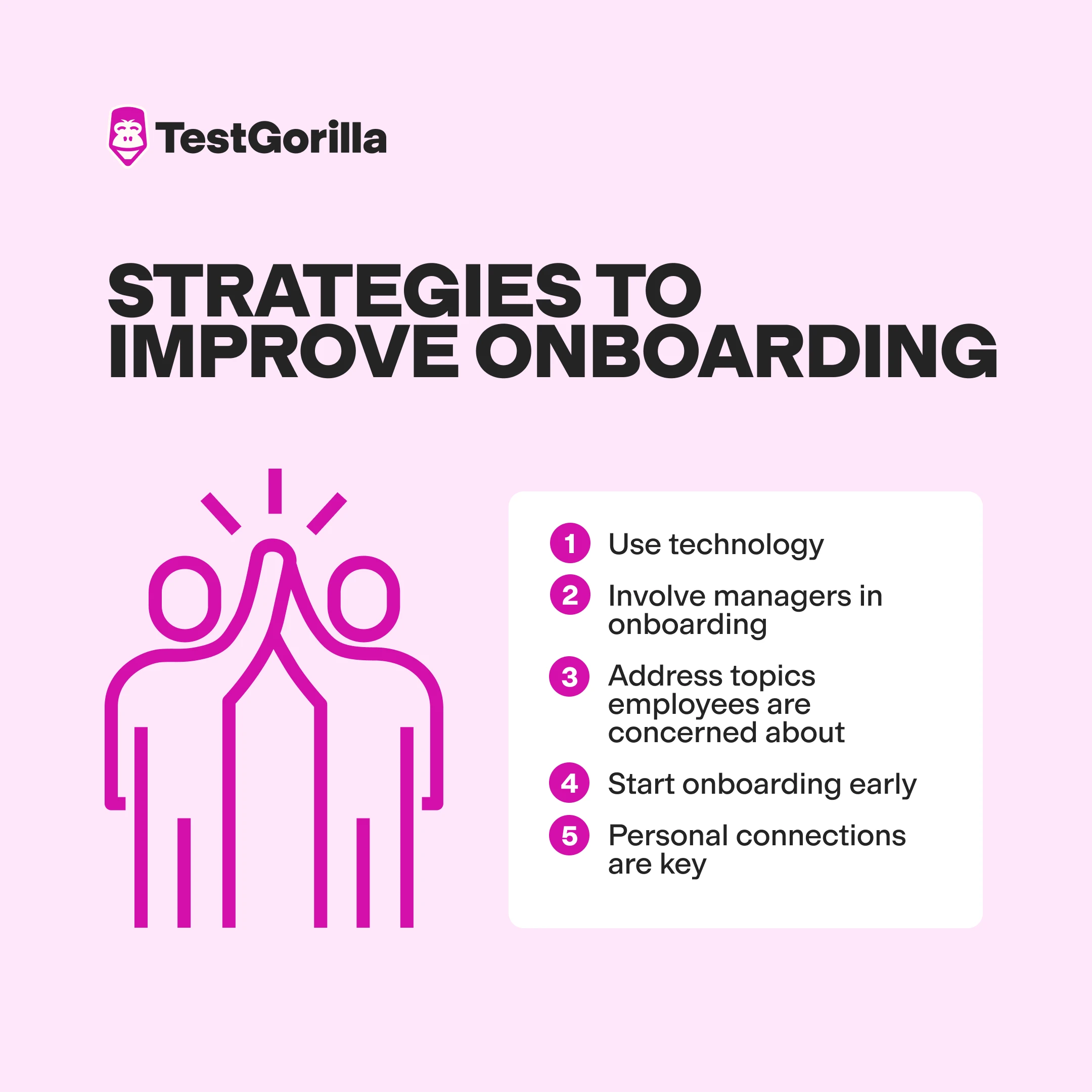A positive onboarding experience can make or break a new hire’s decision to stay with your organization. It also has an ongoing impact on employee engagement, job satisfaction, and company culture.
But how? Read on to learn key onboarding statistics that explain this and more.
Table of contents
- How we researched this topic
- Key takeaways
- What is employee onboarding?
- Key onboarding statistics
- The benefits of effective onboarding
- The cost of poor onboarding
- Key factors that contribute to a negative onboarding experience
- Trends in onboarding
- Strategies to improve onboarding
- Level up your hiring process with talent assessments
- FAQs
How we researched this topic
We reviewed industry reports from well-known onboarding and employee experience platforms, as well as respected research and analysis firms like Gallup and McKinsey. Where possible, we cited statistics that are less than five years old and represent the most up-to-date research into the onboarding process.
Key takeaways
Onboarding helps new hires familiarize themselves with your company’s key internal processes, understand its culture, and learn their role and goals.
Effective onboarding helps improve new hire retention, engagement, and productivity, while a poor onboarding experience can leave employees feeling undertrained, overwhelmed, and confused.
You can elevate the onboarding experience by ensuring the process is long enough, supporting onboarding for remote employees, leveraging technology, and involving managers.
Reviewing onboarding statistics helps you understand its importance for organizational and employee success. Plus, it shows you what makes a truly successful onboarding experience.
The best insights on HR and recruitment, delivered to your inbox.
Biweekly updates. No spam. Unsubscribe any time.
What is employee onboarding?
Employee onboarding refers to the process in which new hires familiarize themselves with your organization and their role. During onboarding, employees learn more about:
How your organization works.
Key internal processes, such as workplace health and safety and internal complaints procedures.
The software and any other equipment they need to do their job.
Your company culture.
Their manager and colleagues.
The expectations of the role and their individual goals.
Onboarding benefits both employers and workers. When done correctly, it can help new hires feel welcome and confident in their abilities to succeed. As a result, good onboarding can significantly improve employee retention, engagement, and productivity – all of which impact your bottom line and company reputation.
Key onboarding statistics
Seventy percent of new hires determine if a role is the right fit within one month of hire, with 29% making this decision in the first week.
As much as 20% of employee turnover occurs within the first 45 days of employment.
Nearly 20% of workers say their recent onboarding was poor or nonexistent.
Only 29% of new hires who received onboarding felt fully ready and supported to perform well in their new roles after the process.
For 52% of new hires, the onboarding process lasted one month or less.
The benefits of effective onboarding
An effective onboarding program can help organizations improve several key HR and hiring metrics, including:
Retention
69% of employees are more likely to stay with an employer for at least three years if they have a great onboarding experience.
Productivity
Onboarding can also help employees become more productive in less time, with 51% of employees saying onboarding improved their time to proficiency.
Engagement
Onboarding helps you increase employee commitment, with 42% of workers feeling more engaged after effective onboarding.
Job satisfaction
Employees with exceptional onboarding experience are 2.6 times more likely to be extremely satisfied at work.
Workers who experienced an exceptional onboarding process are almost three times as likely to say they have the best job.
The cost of poor onboarding
Next, let’s examine stats that highlight the consequences of poor onboarding:
The average cost of onboarding a new hire is $1,830. While this is a comparatively small investment considering the benefits of onboarding, it’s wasted resources if your onboarding process is ineffective.
80% of new hires who feel undertrained as a result of their onboarding plan on leaving the organization soon. Given that – at a conservative estimate – it costs 0.5 to 2 times an employee’s annual salary to replace them, the onboarding process is a crucial opportunity for organizations to reduce employee turnover and save money.
84% of employees felt overwhelmed with the amount of information they received during their onboarding process. This affects their confidence in their ability to do their job and affects their productivity, as it takes them much longer to find the information they need.
A poor onboarding experience left 56% of employees feeling disorientated, 52% feeling let down, and 49% feeling devalued. These negative feelings undermine employee confidence and job satisfaction.
Over half of new hires came out of the onboarding process without a clear picture of the organization’s culture (62%) or core values (53%), making it difficult for them to connect or integrate with the company’s culture.
Key factors that contribute to a negative onboarding experience
The most common reasons employees cite for a negative onboarding experience include:
Confusing orientation with onboarding.
Being ghosted after they’ve accepted an offer.
Receiving too much information.
Being onboarded late – for example, a week or month after they start.
Undergoing an unstructured onboarding process.
Trends in onboarding
Here are some emerging trends in the onboarding:
Remote onboarding
54% of companies now use virtual onboarding. However, there’s room for improvement regarding onboarding remote employees. At the end of the onboarding process, 63% of remote workers feel undertrained, while 60% feel disorientated.
Personalization
You should tailor your onboarding process to address the concerns of specific groups of new hires. For example, Gen Z employees (62%) are more likely to be satisfied with their onboarding experience than Gen X individuals (43%).
Long-term onboarding
48% of HR professionals recognize that onboarding should run for at least three months, despite over half of new hires completing onboarding in one month or less.
Re-onboarding
Re-onboarding involves putting all your employees through the onboarding process again. Using this approach, 47% of workers say they’re more engaged, and retention improves by 43%.
Strategies to improve onboarding
Statistics highlight several ways to enhance your onboarding process:
Use technology
74% of new hires report they used software during onboarding. According to these employees, the most helpful aspects of using onboarding software were:
Accessing the information they needed.
Connecting with their colleagues.
Communicating with their managers.
When it comes to using AI, 83% of employers say they’re very likely to introduce automated onboarding within 12-24 months. In this context, the global market for onboarding applications is expected to reach $2.8 billion by 2025.
50% of employers believe using AI in onboarding will increase employee engagement, and 48% say it will speed up the process.
Involve managers in onboarding
Employees are 3.4 times more likely to say they strongly agree they had an exceptional onboarding experience if their manager took an active role in the process.
Address topics employees are concerned about
97% of individuals believe onboarding should involve training employees on the software and online tools they’ll use in their roles.
97% also want an introduction to employee guidelines, while 96% want to learn the company’s mission statement and values during onboarding.
66% of new hires say job duties and expectations are the biggest obstacles in understanding their role, so emphasizing this during onboarding can be very beneficial.
83% of employees want to know how the company measures performance, and 74% want to learn how to succeed in the organization’s culture.
Start onboarding early
Your employees’ onboarding process should start before their first day of work. Eighty percent of employees who were most satisfied with their onboarding experience reported starting early or “preboarding.”
Personal connections are key
Connections at work are key to employee satisfaction, with 70% of employees saying that having work friends is the most important aspect of a happy work life.
Making these connections should be an integral part of the onboarding process. Nearly 75% of new hires said they made at least one work friend during this time, and they were four times more likely to say they had an exceptional onboarding experience.
69% of new hires who made friends during onboarding said they felt mostly or very informed, engaged, and confident compared to 51% of those who didn’t make any connections.
Returning to personalization, social connections at work are especially important to Gen Z. Two times more Gen Z-ers prefer communicating with team members over their direct manager before starting their new role.
Level up your hiring process with talent assessments
Employers are under pressure to make a good first impression on new hires, and an exceptional onboarding process is a great way to do this. Statistics highlight that a good onboarding program can profoundly impact employee engagement, productivity, and retention.
By personalizing your onboarding process, ensuring it runs for several months rather than days, starting it early, and emphasizing building workplace connections, you can create an onboarding process that helps employees thrive in their new roles.
Effective onboarding sets new hires up for success, but the process starts earlier – during hiring. Using a tool like TestGorilla’s pre-employment assessments to find the best candidates to interview lays the groundwork for a seamless onboarding experience by ensuring new hires have the skills they need to succeed from day one.
To see how TestGorilla can help you find new hires to successfully onboard, sign up for a free demo or try our free plan today.
FAQs
What are the most common mistakes during the onboarding process?
Some common onboarding mistakes include designing a too-short process, failing to help new hires understand their goals and the role’s expectations, overloading employees with information, relying on a disorganized and unstructured onboarding process, and not pre-boarding new hires before they start.
What are the four Cs of employee onboarding?
The four Cs of onboarding are compliance, clarification, culture, and connection. Compliance refers to procedures and policies, clarification defines roles and tasks, culture helps new hires understand and integrate with the organization, and connection emphasizes building workplace relationships.
How do you measure effective onboarding?
Useful HR metrics for measuring the effectiveness of your onboarding process include turnover rates, time-to-productivity, new hire satisfaction, new hire engagement, and first-year retention rates. Various methods for collecting this information exist, including employee pulse surveys, 360-degree feedback, and informal feedback.
You've scrolled this far
Why not try TestGorilla for free, and see what happens when you put skills first.
















